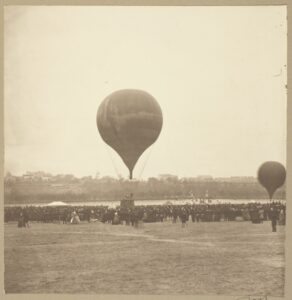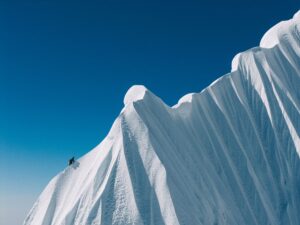Everest’s Daughter, as 7,161m Pumori is often called, casts a long shadow over the Khumbu Valley. It also looms large in climbers’ minds. Its avalanche-prone slopes and history of tragedy make it a rarely chosen option for climbers. Yet its highlights make it tempting for some outfitters and experienced clients.
The name Pumo-ri combines the words Pumo, for a young, unmarried daughter, and Ri for “mountain” in the Sherpa language. George Mallory, perhaps thinking of his own daughter Clare, gave it its name. The daughter allusion also makes sense, given that it lies just eight kilometers west of Everest.
Great location
Pumori is an elegant, pyramidal peak, especially beautiful when snow-covered. It often looms in photos from Everest Base Camp. Pumori climbers may enjoy the comforts of Everest Base Camp and have the entire Khumbu Valley to acclimatize in. As they progress up the peak, they will have the rare view of the summits of Everest, Lhotse, and Nuptse in the same part of the sky.

Everest and Lhotse from Pumori’s highest camp. Photo: Dawa Steven Sherpa/Asian Trekking
“The summit camp on the col is just a magical place,” Dawa Steven Sherpa told ExplorersWeb. “You’ve got Tibet on one side, Nepal on the other, and the snowy flank of Lingtren flowing down toward Tibet.”
Lingtren is the peak between Pumori and Khumbutse, near Everest’s Lho La. From Base Camp, it looks like a clean-cut snow ramp.
A tricky normal route
Pumori’s classic route follows the Southeast Ridge and usually requires three camps. From an Advanced Base Camp (often identified as C1) at 5,500m, the route goes up a snowy, steep face (40-60º) to a second camp at 6,200m. From there, dodging seracs and crevasses, climbers reach a final ice wall, which leads to a col at 6,480m, with views into both Nepal and Tibet. Here, the final camp is set. The summit day also involves steep going and crevasses, but it is safer than the previous parts of the climb.

Pumori’s normal SE Ridge route. The main danger comes from falling chunks of ice that trigger avalanches on the route. Photo: Mountain.ru
Indeed, Pumori’s normal route is technically attainable, especially for commercial teams fixing ropes. But it involves a serious risk of avalanches, triggered by falling pieces of serac poised right above the route.
Dark memories
Pumori has often been associated with drama and death. The mountain has been especially cruel to Spanish climbers. Nine died in two separate avalanches in 1989 and 2001. The mountain’s worst moment came during the 2015 earthquake. A great part of Pumori’s ridge collapsed, triggering a monster avalanche that reached Everest Base Camp and killed 22 (some say 24) people.

Everest Base Camp after the 2015 earthquake triggered a gigantic avalanche from Pumori. Frame from the movie “The Day Everest Shook.”
“Avalanches between Camp 1 and the ice wall are the main concern,” says Dawa Steven. “But I would cautiously say that it’s much less volatile than in the past.”
This spring, he is taking a small team with two highly experienced clients to Pumori. Dawa Steven notes that guided teams fix nearly the entire route in advance.
“A couple of places don’t really need ropes, but they’re still a good route marker,” he said. “If you’re taking clients up there, it’s wise not to leave any part unroped.”

Pumori’s South Face from the Kala Patthar. Photo: Wikipedia/© Vyacheslav Argenberg
Years ago, a number of teams climbed (or attempted) Pumori to prepare for Everest or Lhotse. For others, the “Unmarried Daughter” was a big enough challenge on its own.
Since Pumori’s first ascent in 1962 by Gerhard Lenser of a German-swiss expedition via the Southeast Ridge, a number of further routes have opened. The Himalayan Database lists a total of 264 expeditions, with a 48% success rate. Not counting the earthquake victims, a total of 41 people have perished on the mountain so far.
Pumori in the age of commercial expeditions
In the last few years, fewer teams have targeted Pumori. Independent climbers look for lonelier areas. Outfitters, seeking to minimize risk, use easier peaks to acclimatize, such as Island Peak or Lobuche East.
But Lobuche, in particular, has become seriously crowded. Everest climbers use it for both acclimatization and training with ropes and crampons. Outfitters often list Pumori among their 7,000ers on offer, but they rarely launch an expedition there.
Yet commercial teams have done the most recent climbs here. In 2021, some Indian climbers outfitted by Peak Promotion summited in spring, then headed for Everest. Some days later, UK Guide Tim Mosedale tried it himself but had to turn around because of too much fresh snow on the route.
“It’s a tough climb,” Mosedale told ExplorersWeb. “For most clients, it would completely wipe them out and jeopardize their Everest attempt. “I’d love to be on it again although I probably wouldn’t attempt it with clients.”
Pumori was empty last year, but in 2023, other teams might reconsider attempting the mountain, particularly since Dawa Steven’s party will be there to fix ropes.
Asked whether Pumori is a good preparatory climb before Everest, Dawa Steven said: “I think it’s a little too ambitious for at least half [of them]. But it may be a good training peak for those experienced climbers who want to avoid the crowds in the Icefall and on Lobuche East.”






